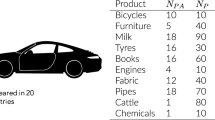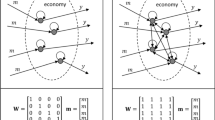Abstract
Much of the analysis of economic growth has focused on the study of aggregate output. Here, we deviate from this tradition and look instead at the structure of output embodied in the network connecting countries to the products that they export. We characterize this network using four structural features: the negative relationship between the diversification of a country and the average ubiquity of its exports, and the non-normal distributions for product ubiquity, country diversification and product co-export. We model the structure of the network by assuming that products require a large number of non-tradable inputs, or capabilities, and that countries differ in the completeness of the set of capabilities they have. We solve the model assuming that the probability that a country has a capability and that a product requires a capability are constant and calibrate it to the data to find that it accounts well for all of the network features except for the heterogeneity in the distribution of country diversification. In the light of the model, this is evidence of a large heterogeneity in the distribution of capabilities across countries. Finally, we show that the model implies that the increase in diversification that is expected from the accumulation of a small number of capabilities is small for countries that have a few of them and large for those with many. This implies that the forces that help drive divergence in product diversity increase with the complexity of the global economy when capabilities travel poorly.
Similar content being viewed by others
References
Acemoglu D., Antras P., Helpman E. (2007) Contracts and technology adoption. American Economic Review 97(3): 916–943
Aghion P., Howitt P. (1992) A model of growth through creative destruction. Econometrica 60(2): 323–351
Balassa B. (1964) The purchasing-power parity doctrine—A reappraisal. Journal of Political Economy 72(6): 584–596
Dixit A. K., Stiglitz J. E. (1977) Monopolistic competition and optimum product diversity. American Economic Review 67(3): 297–308
Feenstra, R. C., Lipsey, R. E., Deng, H., Ma, A. C., & Mo, H. (2005). World trade flows: 1962–2000. NBER Working Paper No. W11040.
Gaulier, G., & Zignano, S. (2009). Baci: International trade database at the product-level the 1994–2007 version.
Grossman G. M., Helpman E. (1991) Quality ladders in the theory of growth. Review of Economic Studies 58(1): 43–61
Hausmann, R., & Klinger, B. (2006). Structural transformation and patterns of comparative advantage in the product space. CID Working paper 128.
Hausmann R., Hwang J., Rodrik D. (2007) What you export matters. Journal of Economic Growth, 12(1): 1–25
Hausmann, R., Rodriguez, F., & Wagner, R. (2006). Growth collapses. CID Working Paper No. 136.
Helpman E., Krugmann P. R. (1985) Market structure and foreign trade. MIT Press, Cambridge, MA
Hidalgo C. A., Hausmann R. (2009) The building blocks of economic complexity. Proceedings of the National Academy of Sciences of the United States of America, 106(26): 10570–10575
Hidalgo C. A., Klinger B., Barabasi A. L., Hausmann R. (2007) The product space conditions the development of nations. Science 317(5837): 482–487
Hirschman A. O. (1964) The paternity of an index. American Economic Review 54(5): 761–762
Hirschman A. O. (1958) The strategy of economic development. Yale University Press, New Haven, CT
Hummels D., Klenow P. J. (2005) The variety and quality of a nation’s exports. American Economic Review 95(3): 704–723
Jost L. (2006) Entropy and diversity. Oikos 113(2): 363–375
Kali, R., Reyes, J., McGee, J., & Shirrel, S. (2010). Growth networks. Working Paper, University of Arkansas.
Kauffman S. A. (1993) The origins of order. Oxford University Press, New York, NY
Kremer M. (1993) The O-ring theory of economic-development. Quarterly Journal of Economics 108(3): 551–575
Krugman P. (2009) The increasing returns revolution in trade and geography. American Economic Review 99(3): 561–571
Krugman P. R. (1979) Increasing returns, monopolistic competition, and international-trade. Journal of International Economics 9(4): 469–479
Lucas R. E. (1988) On the mechanics of economic-development. Journal of Monetary Economics 22(1): 3–42
Maslov S., Sneppen K. (2002) Specificity and stability in topology of protein networks. Science 296(5569): 910–913
Melitz M. J. (2003) The impact of trade on intra-industry reallocations and aggregate industry productivity. Econometrica 71(6): 1695–1725
Mori T., Nishikimi K., Smith T. E. (2008) The number-average size rule: A new empirical relationship between industrial location and city size. Journal of Regional Science 48(1): 165–211
Murphy K. M., Shleifer A., Vishny R. W. (1989) Industrialization and the Big Push. Journal of Political Economy 97(5): 1003–1026
Rodriguez-Clare A. (2007) Clusters and comparative advantage: Implications for industrial policy. Journal of Development Economics 82(1): 43–57
Romer P. M. (1986) Increasing returns and long-run growth. Journal of Political Economy 94(5): 1002–1037
Rosenstein-Rodan P. N. (1943) Problems of industrialization of Eastern and South-Eastern Europe. The Economic Journal 53: 202–211
Saviotti P. P., Frenken K. (2008) Export variety and the economic performance of countries. Journal of Evolutionary Economics 18(2): 201–218
Schott P. K. (2004) Across-product versus within-product specialization in international trade. Quarterly Journal of Economics 119(2): 647–678
Solow R. M. (1956) A contribution to the theory of economic-growth. Quarterly Journal of Economics 70(1): 65–94
Solow R. M. (1957) Technical change and the aggregate production function. Review of Economics and Statistics 39(3): 312–320
Weitzman M. L. (1998) Recombinant growth. Quarterly Journal of Economics 113(2): 331–360
Author information
Authors and Affiliations
Corresponding author
Rights and permissions
About this article
Cite this article
Hausmann, R., Hidalgo, C.A. The network structure of economic output. J Econ Growth 16, 309–342 (2011). https://doi.org/10.1007/s10887-011-9071-4
Published:
Issue Date:
DOI: https://doi.org/10.1007/s10887-011-9071-4
Keywords
- Diversification
- Ubiquity
- Capabilities
- Poverty trap
- Economic complexity
- Structural transformation
- The product space
- Networks




